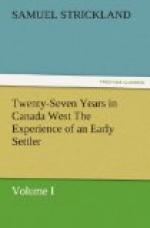The lower town comprises a few acres of alluvial flat, only a few feet elevated above the river. This piece of land was destitute of trees or stumps, and had evidently been cleared many years ago by the Indians, who had cultivated it with Indian corn. I ploughed up this flat of land for the benefit of the Company, and sowed it with oats in the spring of ’29; and, therefore, I can justly claim the honour—for the sake of which I did it—of putting the first plough into the ground of the Huron tract. I also put in four acres of wheat on the top of the hill near the castle, in the fall of the same year, the yield of which was upwards of forty bushels to the acre—a good yield for any country, especially when it is considered that at least one-twelfth of the ground may be fairly deducted for stumps of trees, stones, and other obstructions, usually found in all new clearings. I believe, however, I may say without exaggeration, that the Company’s tract may safely challenge any other block of land of the same dimensions either in Canada East or West, for fertility of soil, average yield per acre, or healthiness of the climate.*
[* “The Canada Company’s Huron tract is known to be one of the most healthy and fertile settlements in Canada. The tract in the year 1842 contained 7101 souls. In June last year (1849) the Huron district numbered 20,450 souls, according to official reports, exclusive of the townships of Bosanquet and Williams. The Canada Company’s tract now contains a population of 26,000 souls, showing an increase of 18,900, and that the population has nearly quadrupled itself in seven years—a progress of settlement of a tract of country scarcely exceeded in any part of the North America.”—Information to Emigrants by Frederick Widder, Esq.]
I bought a small log-house and town-lot, or rather the good-will of them, from a French Canadian, putting myself in his place with the Company, with whom I completed the purchase. The situation was very pretty, commanding a fine view of the Lake. I immediately prepared to build a suitable house, to receive my wife and family, whom I had been under the necessity of leaving behind me in Guelph, till I could make suitable preparations to receive them here.
At this time, there was only one saw-mill* in the whole Company’s tract, and that was ten miles up the river, situated near the mouth of a large creek, which flowed into the Maitland. This mill was built close to one of the finest pine-groves in the block.
[* “In no situation can settlers be distant from a mill, as there are at convenient places distributed throughout the tract twelve grist-mills and twenty saw-mills, and the facilities for communication are very great; for seventeen of the townships are bounded on the one side by the great roads traversing the tract in two directions for one hundred miles in extent, and six of them are bounded by the Lake on the other side.”—Statistics published by the Canada Company.]




